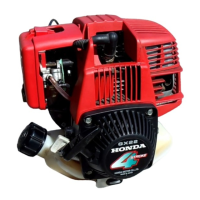
Do you have a question about the Honda GX31 and is the answer not in the manual?
| Compression Ratio | 8.0:1 |
|---|---|
| PTO Shaft Rotation | Counterclockwise (from PTO shaft side) |
| Ignition System | Transistorized magneto ignition |
| Starting System | Recoil starter |
| Dry Weight | 3.3 kg (7.3 lbs) |
| Net Power Output | 0.81 kW (1.1 HP) @ 7, 000 rpm |
| Oil Capacity | 0.10 L (0.026 US gal) |
| Air Cleaner | Semi-dry |
| Engine Type | 4-stroke, overhead valve, single-cylinder |
Discusses the importance of safety and how safety information is presented in the manual.
General safety advice for operating and maintaining Honda engines.
Identifies the location of various engine components and controls.
Explains the function of the choke lever for starting and operation.
Details how the throttle lever controls engine speed and its connection to remote controls.
Explains how to operate the recoil starter grip to crank the engine.
Describes the function of the centrifugal clutch in engaging power at higher RPMs.
Emphasizes the importance of checking the engine's condition before operation for safety and longevity.
Outlines checks for engine oil level, air filter, and fasteners.
Advises reviewing equipment-specific instructions before engine startup.
Reminds users to review safety information and provides a warning about carbon monoxide.
Provides step-by-step instructions for starting a cold or warm engine.
Details the procedure for stopping the engine under normal conditions and in emergencies.
Explains how to position the throttle lever for desired engine speed and provides RPM limits.
Explains why good maintenance is essential for safe, economical, and trouble-free operation.
Outlines critical safety precautions to follow during engine maintenance and repairs.
Presents a schedule for regular engine maintenance based on time and operating hours.
Provides detailed instructions and safety warnings for refueling the engine.
Recommends using unleaded gasoline with a specific octane rating and discusses oxygenated fuels.
Describes how to check the engine oil level before each use.
Details the procedure for draining and refilling the engine oil while the engine is warm.
Provides recommendations for engine oil viscosity and API service classification.
Explains how to inspect the air filter for cleanliness and condition.
Details the steps for cleaning the air filter using soapy water or solvent.
Guides on inspecting, cleaning, gapping, and replacing the spark plug.
Instructs on inspecting and cleaning the engine cooling fins.
Outlines procedures for inspecting the fuel filter and cleaning the fuel tank.
Explains how to service the spark arrester screen by removing carbon deposits.
Provides essential steps for proper engine storage preparation to prevent rust and ensure easy startup.
Details how to use fuel stabilizer to extend fuel storage life.
Explains the process of draining the fuel tank and carburetor for storage.
Outlines steps for preparing the engine with oil before storage.
Discusses important precautions for selecting a storage area and covering the engine.
Advises allowing the engine to cool before loading it onto a transport vehicle.
Lists possible causes and corrections for an engine that will not start.
Lists possible causes and corrections for an engine that lacks power.
Details the location of the engine's serial number for identification and record-keeping.
Explains how to connect a throttle control cable to the engine's throttle lever.
Advises on carburetor modifications for optimal performance at high altitudes and low altitudes.
Discusses the use of oxygenated fuels and their approved percentages.
Explains the source of emissions and the importance of not tampering with the emission control system.
Lists symptoms that may indicate emission-related problems requiring dealer inspection.
Recommends using genuine Honda parts for emission control systems.
Refers to the maintenance schedule and conditions that may require more frequent service.
Explains the Air Index information tag and its relation to engine emissions performance and durability.
Provides detailed specifications for GX22 and GX31 engines, including dimensions, weight, and performance data.
Lists tune-up specifications like spark plug gap and valve clearance.
Shows the wiring diagram for the ignition system, connecting the spark plug and ignition coil.
Lists available Honda publications for additional maintenance and repair information.
Provides contact information and details required for warranty service inquiries.
Summarizes fuel type, octane rating, and tank capacities for GX22 and GX31.
Summarizes engine oil type and capacity.
Summarizes spark plug type and gap specifications.
Summarizes carburetor maintenance tasks, including idle speed and pre-use checks.